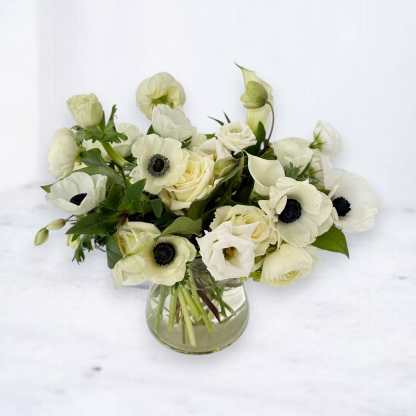The Meaning of Anemone Flowers & Their Stunning Range of Colors
Delicate yet bold, anemone flowers are one of nature’s most captivating blooms. With their striking dark centers and soft, flowing petals, they create an eye-catching contrast that makes them a favorite for floral arrangements. But beyond their beauty, anemones are rich in symbolism, with meanings that vary across cultures and colors. In this guide, we’ll explore the history, symbolism, and the vibrant color range of these stunning flowers.
The Symbolism & History of Anemone Flowers
Anemones, derived from the Greek word anemos (meaning "wind"), are often called "windflowers." According to Greek mythology, these flowers are linked to the tragic love story of Aphrodite and Adonis. When Adonis was mortally wounded, Aphrodite’s tears mixed with his blood, and from the ground, anemones bloomed—forever symbolizing love, loss, and remembrance.
Across different cultures, anemones have taken on unique meanings: ✔ Victorian Era: Anemones symbolized fragility and forsaken love in floriography (the language of flowers).
✔ Ancient Greek & Roman Beliefs: They were thought to bring protection against evil and bad omens.
✔ Eastern Traditions: In Japan and China, anemones are linked to good fortune and protection.
✔ Modern Interpretations: Today, they symbolize anticipation, protection, and change, making them a meaningful choice for both joyful and solemn occasions.
The Stunning Color Range of Anemone Flowers & Their Meanings
Each anemone color carries its own special symbolism, adding depth and significance to floral arrangements.
1. White Anemones: Purity & Protection
Symbolism: Innocence, new beginnings, and protection.
Popular Uses: Frequently featured in wedding bouquets for their graceful beauty, as well as sympathy arrangements to offer comfort and remembrance.
2. Red Anemones: Love & Passion
Symbolism: Deep love, longing, and sacrifice.
Popular Uses: Perfect for romantic gestures such as anniversaries, Valentine’s Day, or memorial tributes symbolizing eternal love.
3. Pink Anemones: Affection & Gratitude
Symbolism: Admiration, appreciation, and friendship.
Popular Uses: A heartfelt choice for Mother’s Day, birthdays, and "just because" gifts to express love and appreciation.
4. Blue Anemones: Tranquility & Inspiration
Symbolism: Peace, wisdom, and clarity.
Popular Uses: Often used in serene, calming arrangements or as a gift for someone in need of encouragement and inspiration.
5. Purple Anemones: Royalty & Mystery
Symbolism: Luxury, transformation, and spiritual depth.
Popular Uses: A stunning addition to luxury floral designs or meaningful bouquets meant to honor someone’s creativity and individuality.
6. Deep Burgundy & Black Anemones: Elegance & Strength
Symbolism: Power, resilience, and dramatic beauty.
Popular Uses: Frequently seen in moody, dramatic floral designs for events, weddings, and gothic-chic bouquets.
How to Use Anemones in Floral Arrangements
Anemones are incredibly versatile and can be used in various floral styles: ✔ Wedding Bouquets: White anemones with eucalyptus and blush roses create an elegant, modern look. ✔ Romantic Bouquets: Red anemones paired with garden roses symbolize deep love and devotion. ✔ Seasonal Arrangements: Mix deep burgundy anemones with wildflowers for a fall-inspired floral piece. ✔ Minimalist Designs: A simple vase of blue or purple anemones can be a sophisticated home décor statement.
Final Thoughts
Anemone flowers are more than just a visual delight—they carry centuries of symbolism and meaning in every petal. Whether you’re looking to express love, gratitude, strength, or remembrance, there’s an anemone color perfect for the occasion.
Want to add the beauty of anemones to your next floral arrangement? Explore our collection and find the perfect bouquet today!

